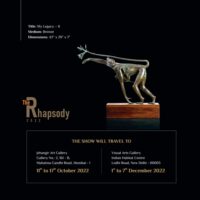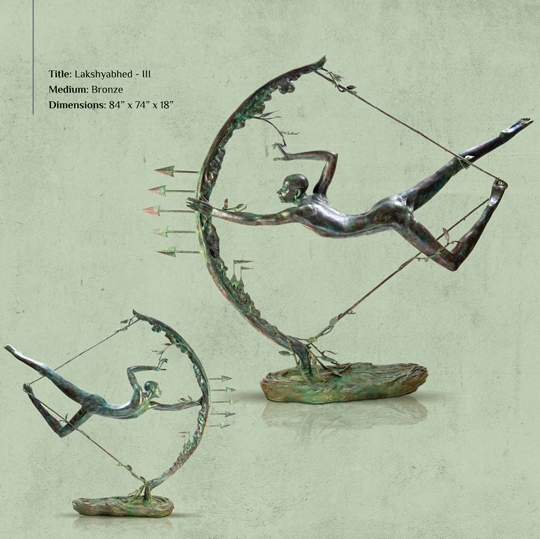The RHAPSODY 2022 An Exhibition Of Sculptures By Renowned Sculptor Asish Kumar Das In Jehangir

From: 11th to 17th October 2022
“The RHAPSODY 2022”
An Exhibition of Sculptures by Renowned sculptor Asish Kumar Das
VENUE:
Jehangir Art Gallery
161-B, M.G. Road,
Kala Ghoda, Mumbai 400 001
Timing: 11am to 7pm
Contact: 98243 57739
Recent work of a renowned sculptor from Baroda, Asish Kumar Das is showing his recent work at Jehangir Art Gallery, Gallery AC-2, M.G. Road, Kala Ghoda, Mumbai 400 001 from 11th to 17th Oct. 2022 between 11 am. To 7 pm.
Metaphorical Sculptures of Asish Das
Baroda based 56 years old, Asish Kumar Das, is one of the outstanding sculptors working in India today especially in the domain of using human figures and animal imageries. Presently we are witnessing in our country the phenomena of projects like installations and such ventures which require collaboration of creative artists as well as technical persons or undertakings where deliberately assembled artists and traditional craftsmen just put together some hybrid patchwork. Amidst such an environment, Asish Das stands out as a multi faceted sculptor who has expertise in all aspects of the bronze casting processes which continues to be his medium for his fascinating, stimulating, captivating, mind arresting sculptures. His works are as much complicated in terms of bronze casting and finishing processes as much as they are intriguing in terms of conceptualization. For an artist with such in depth and subtle creative thinking, it is commendable to observe how he manages to sustain his creative impulses through the long complex technical procedures involved for its concretization or objectification.
Asish Das has intense empathy for the natural animal and human forms so that he does not take recourse to distortions, though he modifies the proportions as required to give them the anticipated elongation, slimness or slight attenuation at the body joints. Consequently his animal and human bodies are graceful with discrete modelling, we as viewers could call them ‘lyrical’ or ‘sukumar’ , corresponding to the ‘Kaishiki Vritti ‘ of Sanskrit language. However they are also ‘serious’ or ‘solemn’, i.e. ‘Gambhir’ or possessing ‘ Audharya ‘ , dignity. Although apparently Asish Das portrays aspiring human beings engaged with daily existential activities in their lives in this world, yet he does not take recourse to oppressed or suffering imageries. The human figures, their faces, limbs, draperies are very patiently modelled in clay and subsequently “hollow casted” in bronze metal using, “the lost wax” process. This technique is often quite complicated when the sculptural form has additional details, such as projecting elements, which require separate channels for pouring hot molten metal during the casting stage. Even when he portrays elegantly modelled animal forms, they too reflect the human aspirations theme, by transforming their faces into those of humans.
Actually the human aspirations as Asish’s thematic concern, are also implied in several sculptures in which the human figure is sometimes associated with a bird, thus a bird like form with long beak is attached around the waist of a man (see ‘The Royal Flight’). Or the man is attempting to fly like a bird, thus he rises on his toes, giving an agile stance to the rising figure. A pair of small metal wings is attached to the shoulders (see ‘The Feminine Upthrust’ ). Alternatively a large pair of wings, shaped in wood planks is hinged with the bronze casted upper back, giving an impression of powerful wings (see ‘The Blissful Draught’ ) . Here we may also draw attention to Asish’s amazing sensitivity of ‘detailing’ such as an exquisite small bird motif with spread out wings, which are delineated on the human torso and the limbs and given buffed polish, so that they shine like gold, amidst the contrasting greenish colour of the patina. In the “ Vanquishing Thought – II”, the figure stands on the toe of left leg with raised right leg, as if the figure is already air-borne. The spread out arms have the gesture of releasing an arrow from the bow. A thin metal sheet covers part of the groin in the front and spreads behind the back as a foil. This metal sheet is perforated with cut outs of the same bird form in fine contours, creating a pleasant contrast with the glittering bird forms on the body. No doubt to render these motifs with finesse requires special skills, which the sculptor has inherited from the fact that he belongs to a family of jewellers. At the same time, this design motif of the soaring bird has a creative purpose which is metaphorical.
Asish’s ingenious command of the balance in his sculptural forms is marvellously arrived at in the manner the human body is placed horizontally in mid space supported by a spiral form in the circular centre of which is placed the three dimensional earthly globe ( see “ Frolicking with Nature”). Another unique example is that of a human figure in dynamic upside down position like that of an acrobat supporting the base or the earthly surface with thumbs of each hand. In this case also spiral form serves as the base ( see “ Bonded with Nature”, bronze and aluminium).
The human figure metaphorically transformed by adding some kind of drapery ( as part of a particular type of costume) along with some details attached to it, thus the associated accessories implying a certain expression or a type of specific character, has been explained by Asish himself, as an unconscious reflection of having seen in his childhood in a Bengal village, the folk actors impersonating a typical character wearing appropriate costume and facial make up, such as long hair and beard. The folk actors are called “ Bahurupi”, thus some of the sculptures comprising of nearly full size human form, are like a “ Bahurupi” impersonating a “ character”. ( see “ I Pave My Destiny – III”).
The combination of naturalism and simplicity with a certain eternal calmness of Asish’s sculptural works, also remind of similar qualities in the ancient Egyptian monumental sculptural forms. The easy flow of line along the contours of simplified abstracted volumes of the Sarnath Buddha images of the Gupta period ( 5th and 6th centuries) is a quality of India’s great classical sculptural style, that has apparently been unconsciously absorbed by Asish Das in his sculptural forms. His handling of delicate surface modelling of the human body along with the equipoise of the human form, links his sculptural forms with the early twentieth century Bengali sculptor, Fanendranath Bose, who had been commissioned more than half a dozen sculptures of Indian male and female workers by the late Maharaja Sayajirao Gaekwad. Asish Das’s work, through the last three decades, has grown and matured consistently in a meaningful direction with surprising variations and creative innovations.
———- Ratan Parimoo
The RHAPSODY 2022 An Exhibition Of Sculptures By Renowned Sculptor Asish Kumar Das In Jehangir
















